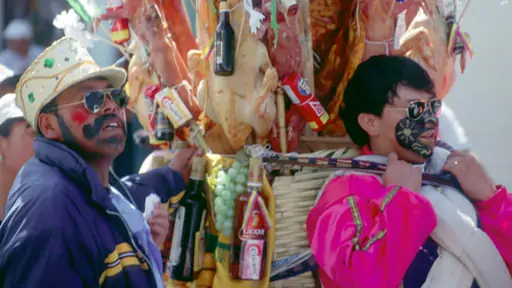Indigenous Calendar September, 2011: Quichua Animism — Fiesta de la Mamá Negra

Ecuador is home to many indigenous peoples. My time there was spent with the Quichua and the Huaorani. I'd visited many remote Quichua villages and had been treated to aspects of their culture that few outsiders get to see. Among these were a traditional oratorio performance and helping to herd cattle and tend land on horseback in the high Andes, taking part in a shamanistic ayahuasca ceremony deep inside the Amazon and attending a wedding anniversary that followed both Animistic and Catholic traditions in a small village at the edge of the Amazon.
While all these experiences were fascinating and unique none of them captured my attention — or the attention of my camera — as much as the annual two-day festival La Virgen de las Mercedes (known locally as the Fiesta de la Mamá Negra) in Latacunga. This is the largest festival of its kind in Ecuador and is something that has to be experienced to be believed.
The exact origin of the festival is unknown. One popular theory is that it originated when the Spanish trafficked Africans to Ecuador to work as slaves. Around the same time the nearby (and still active) volcano, Cotopaxi, erupted. It had erupted and destroyed Latacunga at least three times previously according to historical record. One of the slaves is reported to have prayed to the virgin who answered the prayer by sparing the town. Cotopaxi has not erupted since.
Whatever the origin of the festival is, today it is an enigmatic mix of Catholic, folkloric and Animistic tradition. The Catholic influence is most evident on the opening morning when Mass is held. The purpose of the Mass is in part to hand over the performance roles of the main characters from the previous year to those who will perform them in the present year. Folkloric tradition is to be seen throughout both days as men, women, boys and girls dance through the streets in ancient Incan dress to the accompaniment of loud brass bands. Animistic ritual is often fused with folklore and Catholicism and characters based on Animistic tradition can be found wearing Incan dress and carrying images of the virgin.
The most bizarre image, for me and my camera, was of one of the lesser characters who accompany the whole procession through the town wearing a 'backpack' based around a (real, dead) pig and adorned with other (real, dead) animals, food and bottles of alcoholic spirit — from which they also drink occasionally and often spit the alcohol onto the spectators. I would guess that the average adult man could carry such a 'backpack' for perhaps a few metres at a time; these men appeared to have supernatural powers of strength and endurance.
If you enjoyed reading this article, please consider supporting independent, advertising-free journalism by buying us a coffee to help us cover the cost of hosting our web site. Please click on the link or scan the QR code. Thanks!


